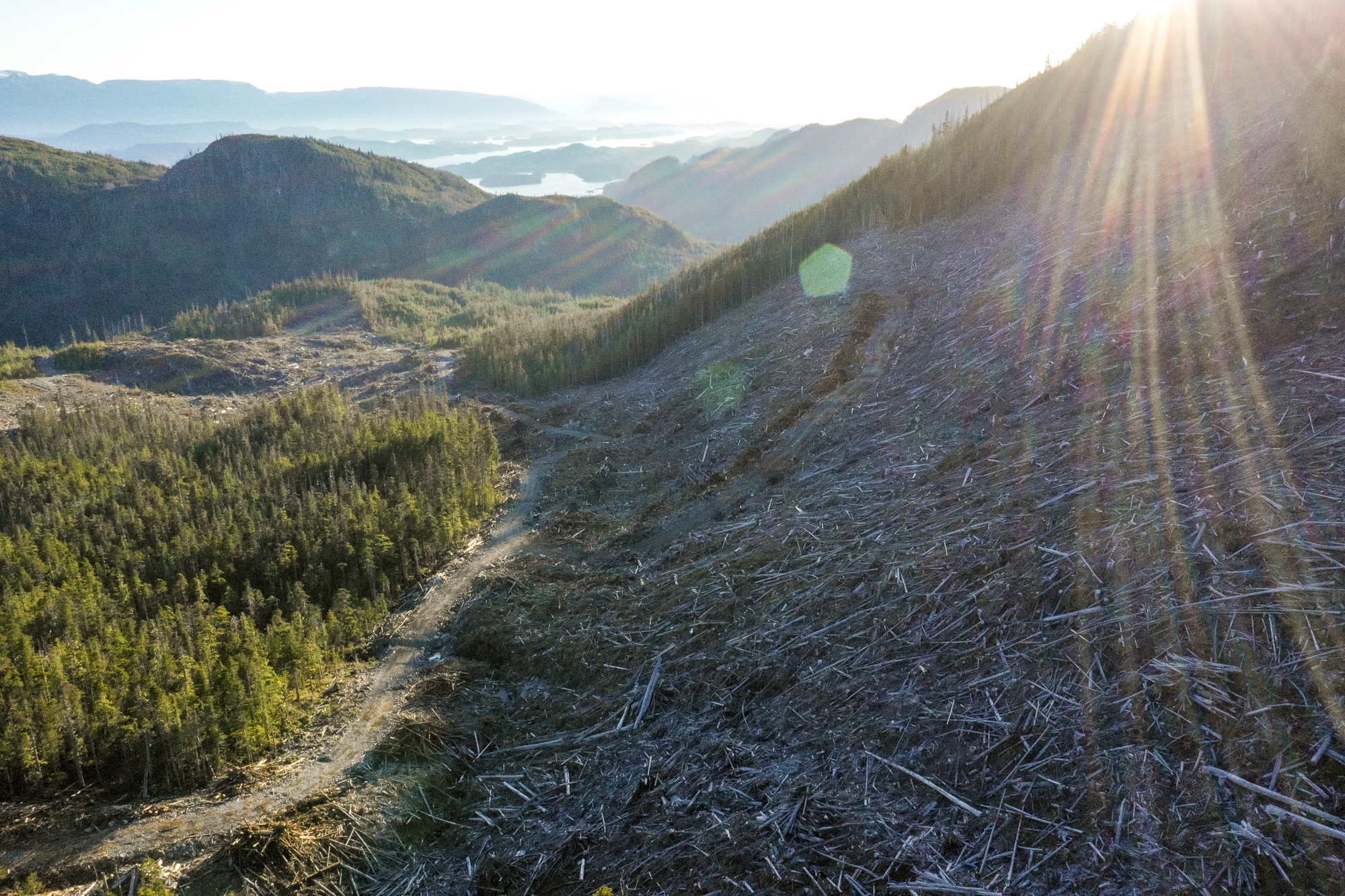
B.C. failing to protect 81% of critical habitat for at-risk species: government docs
B.C. allows industrial logging in critical habitat for at-risk species — part of the reason...
Large numbers of logs are being left behind at logging operations in the Great Bear Rainforest, according to data analyzed by The Narwhal.
The Narwhal investigated the waste levels after receiving photographs of logs abandoned by Interfor on Gilford Island, which is in the southern portion of the iconic temperate rainforest that is known the world over for its ecological values and allegedly leading forest practices.
According to a provincial government database that can be used to track logging rates by individual companies, Interfor — one of the world’s largest lumber companies — logged a little more than 493,000 cubic metres of wood in the North Island-Central Coast Natural Resource District, which includes the southern Great Bear Rainforest, in the first 10 months of 2019.
During that same time period, the company reported leaving behind nearly 115,000 cubic metres of logs. Meaning for every four trees logged and taken to market at least one tree was left behind to rot in the forest from which it was logged.
Photographer Tavish Campbell, who grew up on Sonora Island in the southern portion of the Great Bear Rainforest, documented some of the wood waste on Gilford Island in March of this year, noting droves of yellow cedar and cypress logs left behind.
Campbell told The Narwhal the most extensive waste was higher up mountain slopes where the company was engaged in very expensive helicopter logging, or “heli logging,” operations.

Waste piles containing scores of sizeable cypress tress on Gilford Island. Photo: April Bencze

A map showing the boundary of the Great Bear Rainforest on the coast of British Columbia. Gilford Island, where Interfor logging operations are taking place, is shown by the red square. Map: Carol Linnitt / The Narwhal
“There’s an incredible amount of waste in the heli blocks because they’re only wanting to take the most valuable wood off the hill,” Campbell told The Narwhal.
“In the heli blocks we walked they’re leaving lots of logs. They’re leaving the yellow cedar. They’re leaving the hemlock and the balsam. Anything that’s even slightly substandard, they’re bucking and leaving it there. They’re just targeting the best red cedar.”

Interfor logging operations on Gilford Island in the Great Bear Rainforest. Photo: Tavish Campbell
There is reason to believe, however, that the actual levels of wood waste are far higher than the numbers that the provincial government tracks.
That’s because Interfor and other companies increasingly use an obscure formula for calculating the number and the value of the trees they log — a formula that is almost impossible to verify after the fact. There is no independent auditing of what companies report.
Under the formula, known as “cruise-based” pricing, small sample plots are analyzed and used to project the total number and value of standing trees to be logged on a larger parcel of land.
The assessment is important because it’s also used to calculate exactly what the provincial government will receive from logging companies by way of payments known as “stumpage” fees. The fees are paid to the province in recognition of the fact that the trees are logged on Crown or publicly owned lands and that the public is entitled to a share of the value of the trees after they are logged.

The forests of Gilford Island in the Great Bear Rainforest contain great diversity that may not be reflected in “cruise-based” assessments. However, there are no independent audits to verify if companies are accurately representing the value of trees in cutblocks. Photo: Tavish Campbell
The Great Bear loophole: why old growth is still logged in B.C.’s iconic protected rainforest
Cruise-based pricing is controversial, however, because it only works if the sample plots that are selected truly represent the number, diversity and value of trees on the wider landscape. Because once the cruise assessment is accepted — there is no checking on what is logged after the fact.
Mark Haddock, who recently completed a report on “professional reliance” for the provincial government, warned that there is potential “vulnerability” associated with cruise-based sales because there have been known cases where the volume and the value of trees were underestimated using the system — in one case a witness said he found this to be done deliberately.
If, for example, numerous plots of smaller trees are considered to be representative of the whole, when in fact some plots may have much larger trees, then the larger, more valuable trees aren’t captured in the estimates and the companies pay less stumpage on those trees.

Giant cedars on Gilford Island. Photo: April Bencze
“In the past, there have been known issues with underestimation of timber volume and quality that led to enforcement issues, professional association disciplinary cases and litigation,” Haddock noted in his report.
“Oversight of these policies and procedures depends on government’s capacity to carry out audits and compliance and enforcement, which the Ministry [of Forests, Lands, Natural Resource Operations and Rural Development] acknowledges is very limited.”
The alternative to cruise-based pricing is a more expensive system, in part because it has built in checks and balances. On non-cruise-based logging sites, some logs are actually “scaled” or measured to ensure that the companies accurately report what they say they log. These logging sites are referred to as “normal production” sites in the database, and are also commonly referred to as “scale-based” logging sites.
But no such checking occurs with cruise-based sales. Also, under cruise-based sales there is no reporting on how much waste is left behind because the waste is allegedly already paid for and built in to the up-front calculations.

Interfor logging operations. Photo: Tavish Campbell
All of which means that the actual level of waste at Interfor’s logging operations is likely to be far higher than the numbers reported in the provincial database because of the large amount of wood that is being logged by the company under cruise-based sales.
In the first 10 months of 2019, the amount of logging done by Interfor under cruise-based sales was a reported 298,000 cubic metres or 60 per cent of everything the company logged in the North Island and Central Coast region.
If the unrecorded log waste at the “cruise-based” sites matched that on the scale-based sites where the logging waste must be reported, then Interfor’s log waste levels would rise by nearly 176,000 cubic metres.
“We’ve lost the ability to track at a finer scale, particularly when it comes to these big old trees.”
Jody Holmes, a biologist and project director with the Rainforest Solutions Project, estimates that when all is said and done the actual waste at logging operations throughout the Great Bear Rainforest may be much higher because of the potential for under-reporting with cruise-based pricing.
She notes that next to Interfor, the largest entity using cruise-based pricing is actually BC Timber Sales, an arm of the provincial government that awards allotments of timber to companies that bid on the right to log.

Farlyn Campbell, sister of Tavish, on an Interfor cutblock on Gilford Island. Photo: April Bencze

Logging company Interfor’s operation on Gilford Island, located in the southern tip of the Great Bear Rainforest. Photo: April Bencze
She worries that a “level of detail” is being lost with such sales that makes it almost impossible to verify what is actually being logged in the Great Bear Rainforest, which opens the system to abuse.
“We’ve lost the ability to track at a finer scale,” Holmes says, “particularly when it comes to these big old trees. Those big old cedars are worth exponentially more than the other stuff. You only need four or five of them in a block to all of a sudden make it incredibly valuable.”
In response to emailed questions, the provincial forests ministry told The Narwhal that it is confident that cruise-based pricing is statistically sound and that it ensures that the public gets a fair return for what is logged. The ministry added that the system is designed to “capture the variation” of value in different trees, whether they are big or small, younger or older, or of lower or higher economic value.
“The province believes that these standards are sufficient to capture the variation of the stand,” the ministry maintained. It also added that because cruise-based pricing takes into account the waste that may be left behind at logging sites before the actual logging takes place, that that waste calculation is built into the final prices paid by the logging companies.
This means that there may actually be less logging waste on such sites because there is a built-in incentive for the companies to not leave trees behind. The objective, the ministry said, is to encourage “maximum utilization” of what is logged.

An Interfor cutblock where waste piles were re-harvested for merchantable timber. Photo: Tavish Campbell
The Narwhal contacted Interfor and was instructed to submit emailed questions about logging waste and other issues.
Blaire Iverson, a professional forester and Interfor’s area manager for coastal woodlands ultimately responded with a letter. In it, Iverson said that “the industry as a whole has been working to improve utilization and we are implementing policies that the provincial government has put in place.”
“Interfor is proud of our operations being fully compliant with all legal requirements,” Iverson said.
Update December 17, 2019 3:30pm pst: This article was corrected to clarify that the filing of inaccurate information on the value of trees in cruise-based sales may not necessarily be deliberate, but was described as deliberate by an expert witness. That expert witness told the Forest Appeals Commission that a cruiser working on behalf of Apollo Forest Products “deliberately tried to keep the tree count low.” The commission subsequently found Apollo in violation of the Forests Act.
Get the inside scoop on The Narwhal’s environment and climate reporting by signing up for our free newsletter. Angello Johnson’s shoulders burn, and his arms...
Continue reading
B.C. allows industrial logging in critical habitat for at-risk species — part of the reason...

Lake sturgeon have long been culturally significant and nutritionally important to First Nations in Ontario,...

Mark Carney and the Liberals have won the 2025 election. Here’s what that means for...

